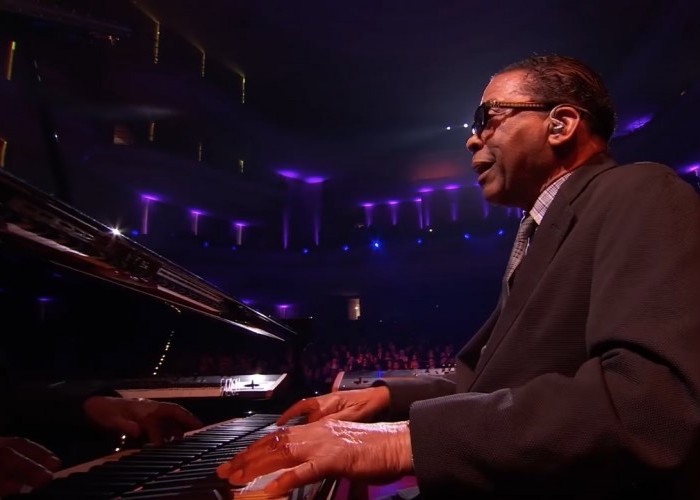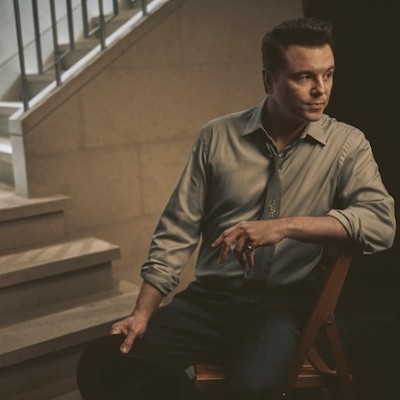Dec 9, 2025 12:28 PM
In Memoriam: Gordon Goodwin, 1954–2025
Gordon Goodwin, an award-winning saxophonist, pianist, bandleader, composer and arranger, died Dec. 8 in Los Angeles.…

Herbie Hancock demonstrated his ageless piano brilliance during the International Jazz Day main concert on April 30 in Tangier, Morocco.
(Photo: Courtesy International Jazz Day)After a five-year hiatus from organizing a host city, International Jazz Day returned in full force this year in Tangier, Morocco. This marks the first time the celebrated event, co-sponsored by the Herbie Hancock Institute of Jazz and UNESCO, has hosted the main country in Africa. In 2020, South Africa was slated to be the host country, but those plans were scrapped because of the pandemic.
Tangier, nevertheless, was an ideal host city. Its history with jazz dates back more than a century, during the Harlem Renaissance, when influential figures such as Claude McKay, Langston Hughes and Anita Reynolds visited the city when it was known as an International Zone. Those artists introduced jazz to the North African city. And in turn, McKay was the first writer outside of Tangier to speak about Gnawa music — a sacred healing music performed by Moroccan descendants of West African slaves.
During the succeeding decades, other international jazz stars such as Herbie Mann, Carlos “Patato” Valdes, Dizzy Gillespie, Ornette Coleman and Archie Shepp would visit Tangier. But hardly any other American jazz artist became so synonymous with the city than Randy Weston, who in 1969 opened the jazz club, African Rhythms in Tangier then three years later, spearheaded the city’s first pan-African Jazz Festival, which featured Dexter Gordon, Pucho and His Latin Soul Brothers, Odetta, Billy Harper and Max Roach.
Weston’s legacy in Tangier and his enduring collaborations with Gnawa musicians, specifically Gnawa master drummer Abdellah El Gourd, anchored much of the music at this year’s International Jazz Day activities.
Four days before the main concert, El Gourd and four other Gnawa musicians gave an enlightening master class at the Dar Gnawa, a cultural center he founded in Tangier’s old city’s medina. Joining the musicians were saxophonist T.K. Blue and pianist Sharp Radway, two musicians who have long established intertwining histories with both Weston and El Gourd.
Blue was erudite in teaching how Weston and other African American jazz musicians connected the dots between Black American spirituals, blues and gospel music to Gnawa music. Most telling, though, was the entrancing music created by the collective. Blue’s serpentine improvisational lines writhed through the Gnawa clacking polyrhythms, concocted by the metallic castanets, qraqeb, embroidered melodic accompaniment of the string instrument gimbri and the haunting antiphonic vocals. Radway underscored the arabesque music with thick chords and prancing passages that alluded to Black American gospel and blues as much as it did modern jazz.
The main concert, on April 30, marked the inaugural performance at Tangier’s Palace of Arts and Culture. Hosted by actor and human rights activist Jeremy Irons, the concert opened, fittingly, with El Gourd and several Dar Gnawa musicians dressed in traditional ceremonial attire. Their percussive and emotionally penetrating performance gave way to a wonderous concert that, again, tipped its hat to Weston, most notably through a rousing rendition of “Blue Moses” featuring Blue, Radway and the Dar Gnawa musicians.
After the concert Blue said the was “extremely elated” from having the opportunity to honor Weston. He also hailed the Dar Gnawa musicians as his “close extended family.”
“My maiden voyage to Tangier Morocco was in 1985 driving from Sevilla, Spain,” Blue recalled. “The very first Gnawa master Randy introduced me to was Abdellah El Gourd. It was an immensely well-deserved gesture to honor Abdellah in this year’s Jazz Day. I always support giving our cherished elders their flowers while they are still with us.”
Under the musical direction of pianist and composer John Beasley, the main concert also pay homage to Tangier’s international ties to Spain with a dazzling reading of the Chick Corea classic “Spain,” featuring splendid lead vocals from Dee Dee Bridgewater sharing the front line with Swedish reedist Magnus Lindgren on flute.
More strong Latin ties came forth from vocalist Claudia Acuña, who led a sterling sextet with a mesmerizing performance of her composition “Futuro”; and bassist Marcus Miller, percussionist Rhani Kyrija, tres player Román Lajara and harmonica player Antonio Serrano on the feisty “Tangier To Havana (Medley).”
The main concert also showed its respect for sub-Saharan Africa with the inclusion of Nigeria’s Afrobeat scion Femi Kuti leading a large combo through his turbo-charged tune “One People, One World”; and Cameroon singer and bassist Richard Bona rendering his gentle waltz “Esoka Bulu.” The most dynamic performance led by sub-Saharan African, however, was South African singer and trumpeter Mandisi Dyantyis’ soul-stirring performance of his ballad “Somandia,” which also featured Mozambican alto saxophonist Moreira Chonguiça.
Dyantyis’ galvanizing performance was only matched by blues diva Shemekia Copeland, who brought the house down with her gutbucket anthem “Nobody But You.” Other highlights include Jazzmeia Horn’s sanguine modern jazz original,“Free Your Mind”; the four-saxophonists romp from Lindgren, Lakecia Benjamin, Jaleel Shaw and Troy Roberts on Sonny Stitt’s quicksilver bebop gem “The Eternal Triangle”; and an equally intrepid “Backwards Bop,” featuring its composer, Billy Childs, on piano, leading a quintet featuring saxophonist Roberts and trumpeter Ambrose Akinmusire.
The main concert paid its respects to a longtime Hancock Institute associate — the iconic Wayne Shorter, who died last year — with a gripping treatment of his classic “Speak No Evil,” featuring Kurt Elling. Hancock got to demonstrate his ageless piano brilliance with a captivating version of his “Cantaloupe Island” featuring alto saxophonist Benjamin and Lindgren on flute.
John Lennon’s “Imagine” once again functioned as the main concert’s grand finale, with its farewell message of international diplomacy, peace and global unity. As with previous International Jazz Days, the speeches and music selections avoided addressing any major world conflicts.
Other International Jazz Day activities in Tangier included jazz master classes inside the Place of Arts & Culture, jam sessions at Chellah Beach Club and a community service event benefiting 100% Mamans, a foundation started in 2006 in Tangier dedicated to helping support single mothers.
“This was extraordinary; this was a homecoming of sorts,” said Dr. Hisham Aidi, senior lecturer in the discipline of international and public affairs at Columbia University, who grew up in Tangier and who wrote portion of the event’s program notes. “Finally, Tangier is recognized for its contribution to jazz.”
When asked how he would like to see the legacy of this year’s International Jazz Day make a sustained impression on the city, Aidi responded: “At the macro level, I hope that it creates an awareness of Tangier and Morocco’s history of jazz. At the local level, I hope it leads people to support Dar Gnawa. I hope this occasion draws support from around the world — from American foundations, from entrepreneurs and from the jazz world — who can support us any way that they can. We need support.”
T.K. Blue echoed Aidi’s sentiments when asked the same question. “The lasting legacy I would love to transpire out of Jazz Day in Tangier is more collaborations and connections between African American artists and the Gnawa community,” he said. “We both share a similar history of overcoming the horrific experiences of slavery. Instead of responding with chaos and negativity, we both created great beauty though the healing sounds of music.” DB

Goodwin was one of the most acclaimed, successful and influential jazz musicians of his generation.
Dec 9, 2025 12:28 PM
Gordon Goodwin, an award-winning saxophonist, pianist, bandleader, composer and arranger, died Dec. 8 in Los Angeles.…

Flea has returned to his first instrument — the trumpet — and assembled a dream band of jazz musicians to record a new album.
Dec 2, 2025 2:01 AM
After a nearly five-decade career as one of his generation’s defining rock bassists, Flea has returned to his first…

“It’s a pleasure and an honor to interpret the music of Oscar Peterson in his native city,” said Jim Doxas in regard to celebrating the Canadian legend. “He traveled the world, but never forgot Montreal.”
Nov 18, 2025 12:16 PM
In the pantheon of jazz luminaries, few shine as brightly, or swing as hard, as Oscar Peterson. A century ago, a…

Dec 11, 2025 11:00 AM
DownBeat presents a complete list of the 4-, 4½- and 5-star albums from 2025 in one convenient package. It’s a great…

Seth MacFarlane takes a turn from his television and film career to sing arrangements made for Frank Sinatra, but never recorded.
Nov 18, 2025 12:04 PM
“I’m not gonna lie to you — I don’t know why I thought this was about The Naked Gun, but I’m happy it’s…